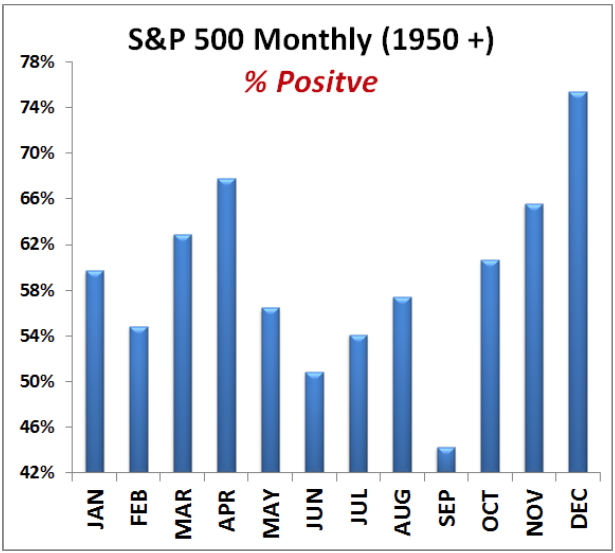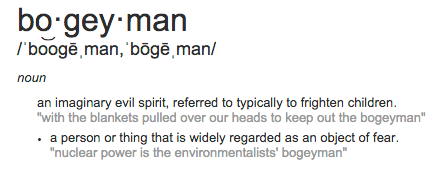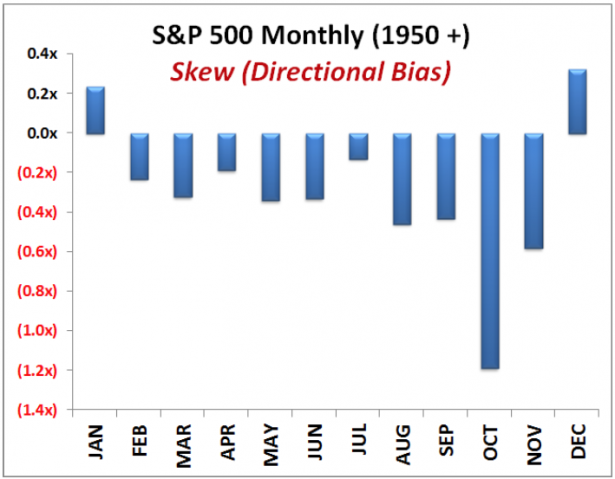Don’t Be Afraid Of The Boogeyman
Don’t Be Afraid Of The Boogeyman
It’s fascinating to me what passes for financial reporting these days. This morning I came across a little jewel by Mark Ackerman who once again blames the big bad Market Boogeyman for the fact that equities have not crashed and burned this fall. I guess it’s that time of the year again – and no I’m not talking about Halloween. After all October is high SKEW month and how dare equities NOT fall off the plate six years and counting! Be this as it may – we are used to seeing our daily dose of doomsday reports and most of it we simply fade out for the useless and unproductive noise it is.

However articles like this follow a cognitive dissonance that we all fall prey to during our life and unfortunately it is not reduced to only the trading domain, it affects all aspects of our life. We will be dissecting this beast like a frog, so let me grab my B.S. scalpel and start cutting away, layer by layer:
In recent days, the stock market has been like an economic roller coaster, rising one day before falling — dramatically — the next.
Isn’t that what markets do? They rise and they fall, they do not move in a straight line or we’d all be billionaires. There is no recipe as to the magnitude of the market’s gyrations. However there are seasonal forces that affect SKEW. If you are not familiar with the term – here’s a definition I lifted right off Investopedia:
“Skewness is extremely important to finance and investing. Most sets of data, including stock prices and asset returns, have either positive or negative skew rather than following the balanced normal distribution (which has a skewness of zero). By knowing which way data is skewed, one can better estimate whether a given (or future) data point will be more or less than the mean.>
Most advanced economic analysis models study data for skewness and incorporate this into their calculations. Skewness risk is the risk that a model assumes a normal distribution of data when in fact data is skewed to the left or right of the mean.”
So to say that ‘in recent days’ the market has been like an economic roller coaster discards the fact that this, to a certain degree, happens every single day/week/month/year. There are periods in which SKEW is historically more amplified and guess which month has the highest SKEW of them all.
Yes, you guessed it – October. I have written about this before and it’s a fact that most of the crashes in history occurred in the fall season. Let’s list the 10 largest crashes by magnitude:
- October 14th 1987 – 22.68%
- October 15th 2008: -7.87%
- December 1st 2008: -7.7%
- October 9th 2008 – 7.33%
- October 27th 1997: -7.18%
- September 17th 2001: -7.13%
- September 29th 2008: -6.98%
- October 19th 1989 – 6.12%
- October 22nd 2008: -5.69%
- April 14th 2000: -5.66%
Obviously October is seasonally prone to attract six sigma events. Does that make it a bad month on average? Well, let’s take a look at some pertinent stats – we love numbers after all:

Turns out on average October is somewhere in the middle, and that includes all the crashes. So it’s really a matter of interpretation. In the last 64 years give or take we’ve had four stock market crashes in October – three in 2008 and one in 1997. That still leaves you with 62 years in which you would have done quite well in equities. That does not mean it’s wise to ignore the potential for outliers in October (like I warned about earlier this month when we were dropping) but neither should you jump to conclusions.
When saying ‘the market these days’ has done x – implicitly suggests that it’s an extraordinary situation/event and that is simply not true. When writing financial newsletters the wording is extremely important as it’s easy to assume a biased tone/approach. Personally I try to be as objective as humanly possible and quite frankly it’s a daily struggle as I, just like you, am not immune to outside stimuli. We can however do our best by limiting our exposure and by questioning every little piece of information based on its merit.
And on those down days, the market often seems as though it has slipped into a free-fall, dropping hundreds of points in just a few hours.
I’ll come right out with it – yes, there probably is a Plunge Protection Team. Is it responsible for lifting the market ahead of potential crashes? I do not know – maybe – there are definitely indications of such attempts. But although I love a good conspiracy theory as much as the next guy I am not willing to base my trading activity or my investments on hunches or hyperbole. If you have ever spent more than a few months trading then you have probably realized that sell offs move much faster than rising markets. It’s an implicit product of human psychology – sell offs are driven by fear and often panic, which accelerates and spreads. All the proof you need is any daily, weekly, or monthly chart. Compare the sell off candles with the buy candles and this intrinsic aspect of market behavior will become clear to you.
Only to rise again before the final bell.
Again, that is a rather common event. I can not count how many sessions follow that script – after a mid day sell off in many cases the dust settles and folks come back after lunch as there are buy back opportunities. Are there large entities who attempt to bang the tape and attempt to trigger a certain response? OF COURSE there are – it’s easily observable by just looking at a LEVEL 2 data feed. But to ascribe this to some mysterious market boogyman is just silly. As the saying goes: Don’t blame the player – blame the game. This has been an inherent aspect of our financial system since day one.
How is that possible? It’s only possible through government intervention aimed at stemming losses and, most likely, to shore up confidence in a the U.S. economy and the leaders (elected and unelected) who are running it:
This is ONLY possible through government intervention? Seriously? Now, I’m not playing super cynic here, just for the record. OF COURSE the government is in kabuz with Wall Street and they are interested in avoiding a panic ahead of elections. But had we been in a crash in April or last year do you think everyone would have already forgotten? I mean there are arguably a lot of empty suits roaming our streets but events like these have consequences which then concludes me to assume that such manipulation occurs on a regular basis. But if it is and is ongoing – was it invented five years ago? Perhaps it was perfected and is now played on a higher level but in the end it all boils down to this: HOW does this affect me the trader/investor? Do I mind trading in a manipulated market? Frankly, I would prefer zero manipulation but I also would like world peace and end hunger. Neither is going to happen in my lifetime. It is what it is and I cannot blame my losses or inability to thrive in what purportedly is a manipulated market on external forces. I mean, if Mark is right here, and there are secret meetings being held right now to prop up the tape ahead of the election, then why not be long and ride it all the way? Actually that’s what we have been doing for five years and counting. And no single market event is going to ever wipe out all the (ill-gotten) coin we have banked by doing so.
Mysterious forces were trying their best, but they couldn’t keep the stock market from swooning >[on a recent day>].
So on one hand the assumption is an all powerful cabal of financial entities working at the behest of the government to keep the market from falling. But then that mysterious force was unable to keep the market from ‘swooning’ – whatever that means. Quite a lot of assumptions here – and none of them tradeable in my book.
They failed in the morning, despite massive purchases of stock index futures contracts. Within minutes of the market’s opening, the Dow Jones industrial average was down 350 points. Later in the day — after a lot of shocking ebb and flow — the Dow bottomed out with a decline of 460 points.
Only in the final hour of the trading day, market saviors achieve a modicum of success, trimming the losses to just 173 points at the final bell. And then, they only succeeded after Federal Reserve Chairman Janet Yellen’s private, but upbeat, remarks about…
Alright – the theme is clear and I won’t continue wasting my time pointing out one cognitive bias after the other. I may be better off gathering a hunting party to track down Big Foot. The bottom line is that thinking like this is sensationalistic at best and if nothing else counter productive to your daily trading activities. It instills fear about things that you have zero control over, which makes you emotional, which then leads to biased and most likely unfavorable trading/investing decisions. And that’s not a place you want to find yourself in.
Do yourself a favor and trade ‘information’ like this for what it is – a lot of hype that has zero productive value – thus it’s noise and should be avoided. Actually I’m going to take a hot shower right now to wash off any traces of emotional bias I may have contracted by dissecting this piece.
Even better: Fade the news completely and instead start working on developing your own personal trading skills – improve your edge – work on your discipline – learn about campaign management and compounding. Because the truth is that I lied to you. There actually IS a market bogeyman and he’s hiding in your bathroom. If you’re quick enough you can catch him right now – he’s staring at you right behind your mirror.

It’s not too late – learn how to consistently bank coin without news, drama, and all the misinformation. If you are interested in becoming a subscriber then don’t waste time and sign up here. The Zero indicator service also offers access to all Gold posts, so you actually get double the bang for your buck.
Cheers,
















